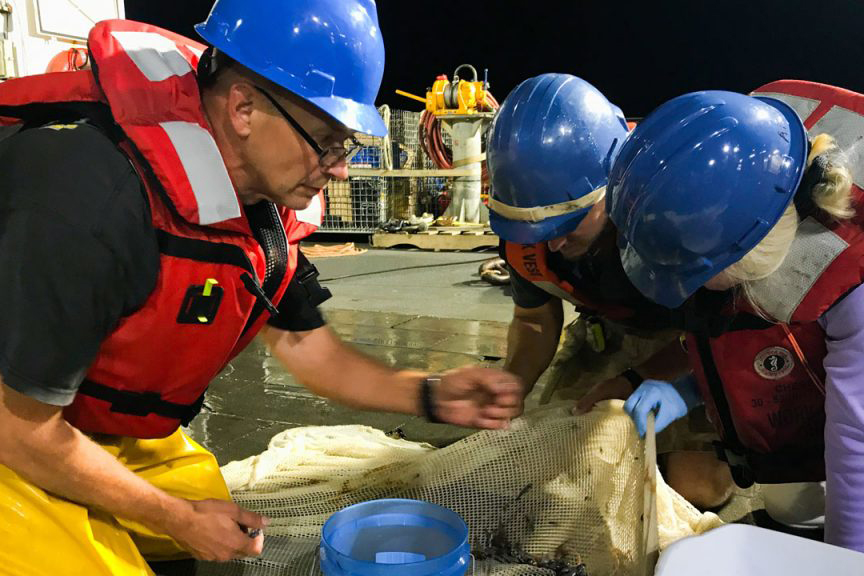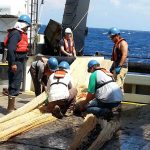
Deep-sea animals, including fish, squid, octopus, and jellyfish, were captured in a large trawl system deployed during a research expedition exploring the deep layers of the North Atlantic Slope Water. As the crewmembers winch the net on deck, scientists are already checking for interesting species caught in the mesh. (Ann Bucklin/UConn Photo)
Bucklin_twilightzone_Bigelow-OTZ_Trawl-Sample_15Aug2018_cropped
Deep-sea animals, including fish, squid, octopus, and jellyfish, were captured in a large trawl system deployed during a research expedition exploring the deep layers of the North Atlantic Slope Water. As the crewmembers winch the net on deck, scientists are already checking for interesting species caught in the mesh. (Ann Bucklin/UConn Photo)
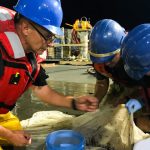
Close examination of a trawl sample from the Ocean Twilight Zone is exciting for everyone onboard the R/V Henry B. Bigelow. Researchers Michael Jech of NOAA National Marine Fisheries Service, left, and UConn’s Ann Bucklin, right, are joined by crew member Andrew Harrison. (Photo by Jennifer Berglund, Oh Sister Productions)
Bucklin_twilightzone_Trawl-sample_lanternfish-16Aug2018
Close examination of a trawl sample from the Ocean Twilight Zone is exciting for everyone onboard the R/V Henry B. Bigelow. Researchers Michael Jech of NOAA National Marine Fisheries Service, left, and UConn’s Ann Bucklin, right, are joined by crew member Andrew Harrison. (Photo by Jennifer Berglund, Oh Sister Productions)
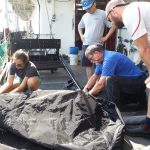
Biological samples were collected using a MOCNESS (Multiple Opening Closing Net and Environmental Sensing System), which can collect zooplankton and fish from targeted layers of the deep ocean. WHOI biologists Peter Wiebe (one of the inventors of the MOCNESS), foreground, right, readies the net for deployment, with from left, Helena McMonagle, Weifeng (Gordon) Zhang, and Paul Caiger. (Ann Bucklin, UConn Photo)
Bucklin_twilightzone_20180810_151656
Biological samples were collected using a MOCNESS (Multiple Opening Closing Net and Environmental Sensing System), which can collect zooplankton and fish from targeted layers of the deep ocean. WHOI biologists Peter Wiebe (one of the inventors of the MOCNESS), foreground, right, readies the net for deployment, with from left, Helena McMonagle, Weifeng (Gordon) Zhang, and Paul Caiger. (Ann Bucklin, UConn Photo)
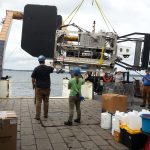
The cruise highlight was the first ocean launch of Deep-See, a towed vehicle equipped with cameras and holographic imaging systems, an acoustic (sound) scattering system, biological samples for water and DNA, and integrated environmental and engineering sensors. Deep-See can be deployed down to 2000 meters and can provide unprecedented views into the ocean’s depths. (Ann Bucklin, UConn Photo)
Bucklin_twilightzone_20180820_110900_cropped
The cruise highlight was the first ocean launch of Deep-See, a towed vehicle equipped with cameras and holographic imaging systems, an acoustic (sound) scattering system, biological samples for water and DNA, and integrated environmental and engineering sensors. Deep-See can be deployed down to 2000 meters and can provide unprecedented views into the ocean’s depths. (Ann Bucklin, UConn Photo)
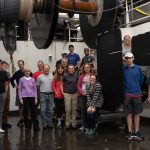
The Ocean Twilight Zone research team, including oceanographers and engineers from the Woods Hole Oceanographic Institution and National Marine Fisheries Service, and UConn marine sciences professor Ann Bucklin (front row, second from left). (Photo by Jennifer Berglund, Oh Sister Productions)
Bucklin_twilightzone_HB1805-Cruise-Photo-3
The Ocean Twilight Zone research team, including oceanographers and engineers from the Woods Hole Oceanographic Institution and National Marine Fisheries Service, and UConn marine sciences professor Ann Bucklin (front row, second from left). (Photo by Jennifer Berglund, Oh Sister Productions)
